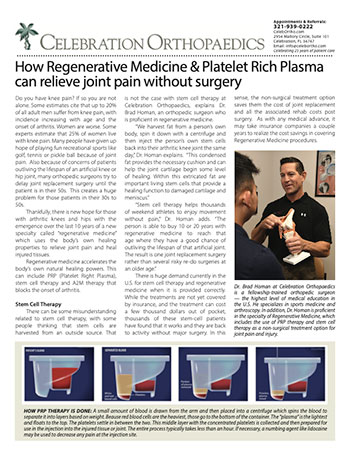PRP Therapy
 What is PRP Therapy
What is PRP Therapy
When you are injured, your body automatically signals for help and calls your platelets, white blood cells, red blood cells and other components within your body to travel to the site of injury. Once there, these cells communicate with each other to release specific growth factors that initiate a healing process.
When used at the site of injury, the growth factors and other components in platelet rich plasma (PRP) have been clinically shown to potentially accelerate the healing of injured or poorly healed tissue, thereby improving function and decreasing pain in patients of all ages and activity levels without surgery.
How PRP Works
PRP therapy typically takes around twenty minutes to complete per treatment. Firstly, the physician collects a small sample of the patient's blood. The blood sample is placed in a centrifuge to separate the platelet-rich plasma from the other components of whole blood. Doctors then inject the concentrated platelets into the site of the injury, usually using ultrasound guidance to assist with accuracy. Platelets function as a natural reservoir for growth factors that are key in repairing injured tissues. The growth factors that the platelets secrete stimulate tissue recovery by increasing collagen production, enhancing tendon stem cell proliferation, and promoting tenocyte-related gene and protein expression. These growth factors also stimulate blood flow and allow cartilage to turn more firm and resilient. PRP activates tenocytes so that they are able to proliferate fast and produce collagen to repair injured tendons, ligaments, cartilage, and muscles.
The number of injections will vary depending on the individual condition of each patient, but it could range from one to three injections. Patients typically experience a significant reduction in pain following the first or second injection. Typically, PRP injections are not painful, but the discomfort level will depend on the part of the body that is treated. Injections that go into the joint tend to produce minimal discomfort.
Conditions Treated with PRP Therapy
Here at Celebration Orthopaedics, we have seen that PRP injections are the most effective for the following conditions:
- Lumbar spine disc pain
- Rotator cuff injuries, including partial-thickness injuries
- Shoulder pain and instability
- Tennis and golfer's elbow
- Hamstring and hip strains
- Knee sprains and instability
- Patellofemoral syndrome and patellar tendonitis
- Ankle sprains
- Achilles tendonitis & plantar fasciitis
- Knee, hip, and other joint osteoarthritis Nerve entrapment syndromes, such as Carpal Tunnel Syndrome Sacroiliac (SI) joint dysfunction and pain
- Lumbar and cervical facet dysfunction and pain
Moreover, PRP can also be effective for many cases of osteoarthritis by stimulating a healing response and cutting down on pain and disability. Types of osteoarthritis that can be treated by PRP include:
- Knee arthritis
- Hip joint arthritis
- Shoulder arthritis
- Ankle arthritis
Preparing for PRP Therapy at Celebration Orthopaedics
If your physician at Celebration Orthopaedics recommended PRP therapy for your joint problem, there are several things you should do to prepare for your PRP treatment:
- Avoid NSAIDS (Advil/motrin, naproxen, voltaren) and aspirin for at least one week prior to and one week after the treatment. Use Tylenol for pain if needed.
- Drink plenty of water for 24 hours prior to the procedure.
- Light exercise prior to the procedure improves platelet count in blood.
- Avoid cigarette/cigar smoking during the course of treatment.

